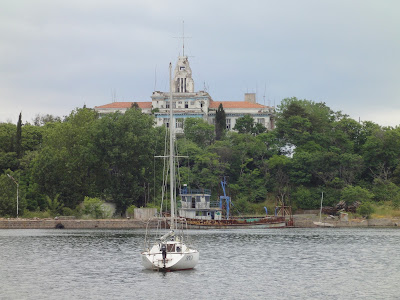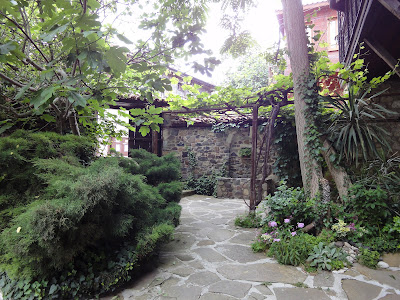This essay is about Sozopol, the identical twin of the more famous town of Nessebar on Bulgaria's Black Sea coast. The reason I visit Sozopol is, after spending one day each in Burgas, Nessebar and Varna, I did not want to spend the rest of my one-week stay in Bulgaria in the area of Sunny Beach, so I woke up early, took a bus to Burgas, and changed onto another bus from the municipal bus station next to Burgas' train station to Sozopol.
Like Nessebar, Sozopol is another thriving Black Sea town known for its Bulgarian-Balkan style architecture, with a base and ground floor made of stone and an upper-part made with wood. The old town of Sozopol is full of them, but just as in the case of Nessebar, I must say I did not find Sozopol particularly interesting either. For some reasons the Black Sea coast of Bulgaria always seems to have that gloomy, enclosed and unhappy feeling, characteristic which are in stark contrast to my own personality. I have always preferred sunny bright towns in Turkey, Greece and Spain, and I did not know what to say about Bulgaria's Black Sea towns.
So, after a quick walk around the entire old town - it is not that big actually and the style of this place is fairly similar to Nessebar, except that Sozopol's old town is not as touristic and commercialised as its twin sister - I thought the best way to spend the next two hours before returning to Burgas would be to find a nice place next to the sea and enjoy some afternoon tea with snacks. To my disappointment, this town does not seem to be overflowing with scenic cafes offering unobstructed views of the Black Sea. There are of course restaurants and bistro bars that are open, but the things on offer on their menus simply do not sound enticing enough to warrant trying out, given that prices in Sozopol are not exactly cheap either.
After a long search inside Sozopol's Old Town, finally I encountered this small hotel with a poolside bar that offers some refreshments and hot drinks. For some reasons their restaurant was not open for business although tourist season along the Black Sea coast of Bulgaria has already begun. I had to settle for a coca-cola instead. Well, at least the views of the sea from their poolside are not too bad.
Sozopol has a long history which dates all the way back to the Bronze Age. Being one of the oldest towns in Bulgaria, its present site was founded by Greek colonists from Miletus (present day Milet in Turkey) and used to have a temple with a giant statue of Apollo, which was later transported to Rome. In ancient times, Sozopol had had close trade relations with cities and the island states all over the coast of Asia Minor, the entire Aegean area, and Greece proper. Its trading partners included towns in Thrace, Athens, Miletus, Corinth, Rhodes, Chios, Lesbos, and Rhodes.
Ruled by Byzantine and the Ottoman Empires, and being less than two hours by car from Turkey's Thrace, Sozopol used to have a considerable Greek population until the early 20th century, when all of Sozopol's ethnic Greek population was exchanged with ethnic Bulgarians from Eastern Thrace. If one looks carefully, signs of a previous Greek existence still exist around this city, in the form of some archaeological diggings.
Nowadays, Sozopol feels neither Greek nor Turkish in spite of its long association with both. Some will probably say I am too demanding and mean to label Sozopol a boring place, but it does not happen to me too often when I am on a day-trip that, instead of rushing for the last bus (because of spending too much time wandering around taking photos or drinking coffee), I had too much time to spare and was trying to find something meaningful or not so meaningful to do in order to fill the time gap before the next bus departs. No offence to Bulgaria's Black Sea coast, but it really is not my cup of tea.
Frequent buses connect Sozopol with Burgas, the trip takes about an hour. Tickets can be purchased directly on the bus from the bus driver. Unless you enjoy gloomy kind of seaside town, one afternoon should suffice to explore this town.
Copyrights@2012. All text and photos by YC Cheng. All Rights Reserved.

















No comments:
Post a Comment